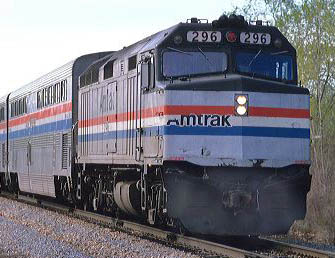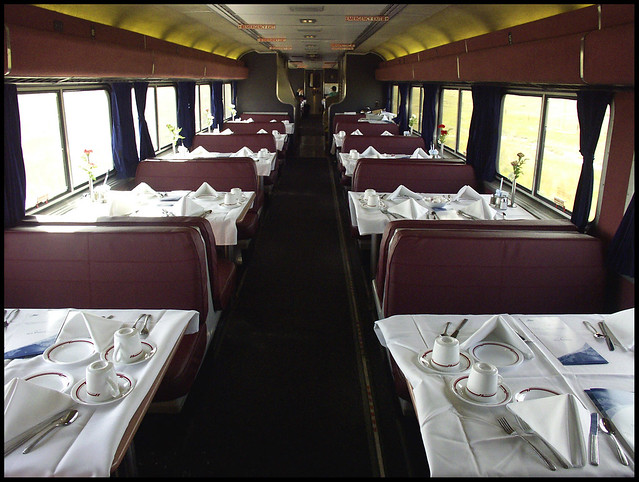President Obama's proposal to spend $50 billion on transportation infrastructure—including 4,000 miles of rail lines—couldn't be a better expenditure of our federal tax dollars.
After spending two days on the Empire Builder, the long-haul Amtrak line from Chicago to Seattle/Portland, I quickly realized that our investment in trains should be readily and heartily embraced. And, if more Americans were to take such trips, I’m sure they, too, would choose trains as an alternative mode of travel.
Amtrak staff was courteous and responsive to passengers, a bit quirky as train people can be, but absolutely delightful while we all traveled the miles and hours together across the country. Riding the train, especially on an overnight, was romantic and adventurous and we kept to our schedule despite the numerous times we had to yield to freight trains.
Actually, it’s a miracle that Amtrak has lasted these past 40 years since President Richard Nixon deliberately designed it for failure. Different administrations—both Democratic and Republican—have either ignored passenger rail or, like President George W. Bush, actively sought to scuttle it.
James McCommons, author of Waiting on a Train: The Embattled Future of Passenger Rail Service (2009) tells the story about Amtrak and America’s relationship with trains along with some great travelogues of his year-long train trips around the country.
He points out that most legislators who vote on appropriations for passenger trains have never ridden a train, which severely works against Amtrak. Others have been adamant that Amtrak make a profit.
Truth is, there is no public transportation system in the world that earns a profit.
What is clear is that train networks serve as a means to an end, namely, they contribute to an area’s economic development, an idea that is capturing the attention of more and more mayors across the country, especially in this weak economy.
Actually, highways and airports are not money-makers either and the federal government subsidizes them to the tune of $180 billion per year. Amtrak only gets $1 billion. Unfortunately, many Americans don’t realize that a transportation network is one of the benefits of their taxes.
The reason that Amtrak has been short-sheeted is that passenger rail has simply not been a government priority.
After 100 years of moving people within our cities and around the country, trains lost favor because people were sick of the rapacious and corrupt conduct of the railroad corporations. The vehicles were dirty and staff was rude or mean. Ridership had been steadily declining since 1920. After World War II, the nation made a dramatic switch to invest in highways because our roads were poor and lacked connectivity and, well, people liked driving their cars. It didn’t help that the automobile, oil and tire companies conspired—or at least lobbied—against the public transportation system for their own interests as depicted in the 1996 PBS film, “Taken for a Ride” and its 2008 Part II version.
Promoted by President Dwight D. Eisenhower, the Federal-Aid Highway Act of 1956 required citizens to finance the Interstates by paying 15 to 20 percent of the price of a gallon of gas. The 46,876-mile Interstate system took 35 years to complete and cost $128.9 billion. The feds paid 90 percent of the cost or about $114 billion—$425 billion in 2006 dollars— even though the Interstates were under the control of the states. Governors and mayors signed onto this massive public works plan without hesitation because they saw it as an economic development tool for their cities. They would be proved wrong within a couple decades.
As more and more people needed and bought cars, they found themselves stuck in more traffic jams and having to contend with endless road repair. Operating an automobile amounted to $6,000 to $7,000 per year (outside its purchase) and the accident and death rates related to cars—at least 40,000 deaths per year—were overwhelming.
Building the Interstates in the cities also drastically changed urban life, something Eisenhower never intended and experts never foresaw. Neighborhoods were torn up to make way for the highways. Social stratification and racial discrimination intensified as middle class white people migrated to the suburbs and left poor people and minority groups behind in the cities. Downtowns that were designed for pedestrians became congested places and the influx of cars made them frustrating to navigate. Old buildings were demolished to create surface parking, which then created gaping, ugly holes in the cityscape. People felt unsafe and increasingly reluctant to go downtown. Retail moved out to the suburbs and the companies eventually followed. Of course, all of this out-migration ended up depleting the tax base and making ghost towns out of our once vibrant and prosperous downtowns.
By the late 1990s transportation engineers and analysts began questioning the Interstate’s “externalities” as they costed out pollution, energy waste, land disruption, accidents, time wasted in traffic jams. They also learned that spending hundreds of millions of dollars to add highway lanes and interchanges didn’t relieve congestion.
The airlines tried to make up for their operational costs with reduced legroom, poorer air quality and overcrowding. Greater demand for air travel also necessitated building or expanding airports, which all takes up a lot of tax dollars.
With the 1990s came new attitudes toward cities and toward the environment. Young people and empty nesters found cities a “hip” place to live and began moving back. They reduced their car usage and demanded more public transportation options. People started a movement to restore historic buildings and revitalize their downtowns.
Meanwhile, rail advocates were keeping Amtrak alive, albeit by a thread. Among them was Gil Carmichael, a former highway lobbyist, owner of five car dealerships and an airport charter service. He later founded the Intermodal Transportation Institute at the University of Denver where he advocates for what he calls Interstate II.
Interstate II involves double- or triple-tracking 20,000 to 30,000 miles of mainline freight railroads, establishing corridors for high-speed trains and eventually electrifying the trains to replace diesel engines. Carmichael estimates this could all be done in 20 years for two cents on the motor fuel tax.
“We have this incredible railroad network that goes out all over this land from city center to city center. That's what is so amazing. It's already there,” said Carmichael (in McCommons).
Another idea train advocates promote is the re-establishment of a combined freight and passenger rail system through private-public partnerships that work with state transportation departments. Dedicated passenger lines have a multiplier effect that can relieve traffic congestion, reduce freight bottlenecks, diminish flight delays, reduce this country's carbon footprint and accommodate people without cars or the means or desire to fly.
When Amtrak was created, politicians, lobbyists and fiscal conservatives really wanted to deep-six passenger rail altogether within two years. It was only through political wrangling and arm-twisting that train advocates were able to save passenger rail by separating it from freight and calling it Amtrak, the National Railroad Passenger Corporation. That did not mean, however, that it would be efficient, well-funded or make a profit despite Nixon’s caveat that the new railroad be off the government dole as soon as possible.
The United States has never had a vision for an integrated railroad network nor has it adequately funded one, says John Gibson, vice president of Operations Research and Planning at CSX (quoted in McCommons). Instead, passenger rail has been a hit and miss enterprise as Amtrak has tried to put its trains on networks owned and managed by the freight companies.
Could there be a renaissance in trains? Yes, says McCommons, because as the nation’s population increases, as more people decide to lead urban lives and as cities increase in density, it makes sense to use rail—especially with energy costs expected to climb.
“In terms of efficiency—fuel savings, lower carbon outputs, smaller footprint on the landscape—the advantage is really rail,” said Armando Carbonell of the Lincoln institute of Land Policy in Cambridge (quoted in McCommons). “It has been significantly underinvested in and disadvantaged against the other modes. We once had good train service in this country. We need to recover that capacity.”
The Obama administration clearly sees the possibilities of rail and so it gave Amtrak $8 billion in the stimulus package and another $1.3 billion for car rehabilitation and infrastructure repair on the Northeast Corridor. Vice President Joe Biden, a well-known train buff and consistent passenger during his senatorial days, obviously had a lot to do with this boost for Amtrak.
This is all a good start but we still have a long way to go.
So, ride the train if you haven’t already, and encourage others to ride also, including your congressional representatives. It's a great way to get this country back on track!








